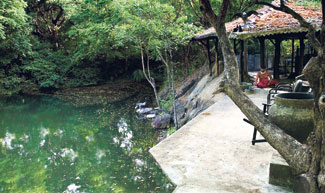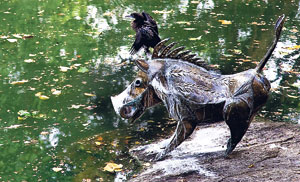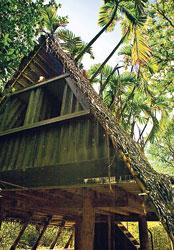| Laki Senanayake - painter, sculptor, architect, landscape designer, and inventor – is woken from deep sleep by someone tugging on his toe. There are strangers in his house and they have one question – can we see the garden? As he has so many times before, Laki says yes. Sri Lankans have long embraced Laki as their renaissance man, and among his thousands of creations, few bear his mark as completely as does Diyabubula, his home in Dambulla.
With Diyabubula, Laki has created a garden that rewards the persistence of his uninvited guests. But perhaps ‘garden’ is too tame a word – Laki has grown a veritable Eden in the dry zone; a paradise in which lakes reflect pristine forest alive with chattering monkeys, rusty spotted cats, monitor lizards, fluttering birds, otters, and of course the archetypal serpent.
 |
His home has become what Laki likes to call an eco-refuge. During the day this means simply that you can enjoy watching large tender-lipped fish swim leisurely in his lake or spot the rare three-toed kingfisher as it perches on a slender branch. During the night, however, lying on a mattress in Laki’s wall-less house, there is much to disturb your sleep. The sudden rustling in the foliage, the patter of feet on the roof and the splash of bodies in the water are accompanied by the occasional tortured shriek of a frog being consumed by a snake. The crunching sound you hear are otters devouring clams - by morning all you will find are the little heaps of shells that commemorate their feast.
Laki will tell you that living symbiotically with nature is much harder than it sounds, and he seems constantly engaged in a battle with the termites and ants. He will not destroy their mounds, but instead attempts to placate them with little offerings of wood and food. “We have a super eco-garbage disposal system,” he says, explaining that organic stuff is cleaned up with startling thoroughness by a team that includes turtles, black ants, monitor lizards and fish. Looking out, it seems he feels only one thing is missing from his domain – “I’d love to have a little crocodile,” he says.
Named for the spring that feeds a system of over eight interconnected lakes and ponds, Diyabubula is mostly forest and water. In one corner is Laki’s house. A simple affair, made mostly of corrugated iron sheets and sturdy wooden pillars, it has two floors. Laki lives and works on the upper floor, and his favourite perch is a swivelling chair that sits on the long deck overlooking the lake and the forest. At least once a day, he will sit on the floor by the pillar in the corner and paint. Aside from some plastic sheets that protect the house from the rains, the structure is left wide open to the elements, though Laki has one room that he built for guests who are afraid of snakes. “The problem with minimal architecture,” says Laki frankly, “is that you have to learn to live minimally.”
 |
| Wild boar by the water: One of Laki’s unique sculptures |
It is hard to imagine that when a 34-year-old Laki first came here in 1971, this was farm land. It was then owned by his brother, who had resolved to try his hand at agriculture. “I was bored with working in Colombo so I decided to quit Ena de Silva’s batik thing, and with the Handbook for the Young Farmer in hand, I came out here to grow chillies.”
Though they raised a fine crop, there was not much profit to be had, and Laki eventually bought the land from his brother and settled down to growing himself a forest. He weeded out over 45 coconut trees to plant trees that grew naturally in the dry zone. There are still the few odd ones out, however. “For a purist it hurts to look at them, like that royal palm tree that never grows in the dry zone. When you look at it in this foliage, it stands out like a tourist,” says Laki.
Other less obtrusive trees bear gaudy fruit. A nil verelu tree produces round fruit in a particularly fetching shade of electric blue. Laki found it on one of his many drawing expeditions to the Peradeniya gardens. There, trees would put down seedlings, which would in turn be mowed down by ruthless gardeners. Over the years, Laki has rescued many and brought them here. Grown in his nursery, many have been re-planted all over the island.
It turns out that among other things, Laki grows trees for a living. One of his first orders was for 150 trees for Geoffrey Bawa’s world renowned Kandalama Hotel. He waters them with the water from a wet weather stream that comes down from the hill and as well as from his spring. But also on the land is his “shack”, a workshop in which he creates his wonderful sculptures. In the shack, the goat god Pan stands prepared to abduct a youth. Several new sculptures dot the grounds.
Owls are a clear favourite, though a golden, geometric chandelier destined for a client takes up the most space in his living area. A particularly fine wild boar seems to skid to a halt by the water, his dignity lessened only by a white snout covered with bird droppings – courtesy a cormorant who loves to perch between his ears.
 |
| The house of living palms |
Laki’s grounds are dotted with his experiments. Here: a “living house” whose structure is made of growing palm trees, while there: dams made out of corrugated iron sheets prevent erosion, help maintain his reservoir of water and collect rich silt for him.
Laki keeps Diyabubula in a constant state of transition. His devotion to aesthetics is so complete that he has not hesitated to tear down and rebuild his house to improve his view. Even within his house, floor space has suffered somewhat since Laki decided that a few feet of floor was obstructing his view of one the lesser ponds and the adjoining rocks. Part of the structure rests on these sturdy monoliths, and because they radiate heat, Laki has created a little waterfall inside the house that slides over the rocks and leaves them cool and glistening. “Just like air conditioning,” says Laki, satisfied.
Appreciating Diyabubula is sometimes in the details. Outside the kitchen, a curling tree pattern is etched into the cement floor. Watered by the overflow from the lake, it gleams beautifully. A moon trap on the corner of his deck, reflects the moon on to his ceiling. And listening to music in Diyabubula is an experience in itself.
Laki’s speakers (appropriately armoured against marauding monkeys and rain storms) are placed all across the land, such that the music is carried across the waters and into the house. Laki has a decidedly offbeat taste in music, and one cannot help but wonder what his neighbours think when caterwauling breaks out as some obscure French band performs a cross between opera and experimental theatre.
For those who live and work with him, Laki is an unconventional master. He has a unique whistle to call every person working here, so uncannily bird-like that you cannot quite distinguish it from the sounds of the surrounding forest. His experiments are clearly something of a mystery to his staff, and are not helped by his preference that they sweep the lake for leaves and leave the garden alone.
Laki enjoys it all with every appearance of unquenchable good humour. He spends his days watching the forest live around him, taking long naps and creating his beautiful paintings and sculptures with seeming ease. If occasionally he sits down to lunch, only to find a trail of sightseers walking through his kitchen, seeming to wonder who he is, he takes it all in his stride. In more than one way, it is an enviable life. |



